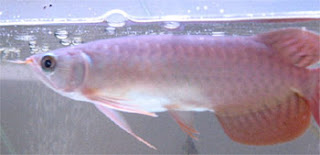This was taken from an article that we wrote in 2005. I am reproducing it here to share since there has been renewed interest in home breeding of arowanas as seen by the posting in our Facebook page.
As seen on Shin Min Daily News on 16/05/2005
Translated for members by NSK
7 years ago, Mr Richard Goh spent S$80,000 to purchase 30 top grade Asian Arowanas. 7 years later, he was handsomely rewarded when one pair of his arowanas (1 male golden crossback arowana and 1 female red arowana) successfully breed in his own courtyard! This feat also made him the first arowana enthusiast to successfully breed arowanas in a residential property in Singapore.
In the presence of an official from The Agri-Food and Veterinary Authority of Singapore (AVA), Mr Goh successfully harvested 28 arowana fries from the brooding male arowana, each measuring only 2 inches long but worth a total of $80,000!
While Mr Goh has been an arowana enthusiast for the past 20 years, this is only the third time that his arowanas mated and the only time that he successfully harvested the arowanas. His passion in the hobby is clearly spelt out as he has spent close to $500,000 for the past 20 years on the hobby, including building a pond in his courtyard to house his arowanas and more than 60 arowanas in his house! The oldest arowana in his house is a 13 year old red arowana that measures more than 2 feet long!
AC: Mr Yap, is this the first home harvest in the world?
Mr Yap: No, there are several occurrences elsewhere which were not officially reported. The only case that was previously reported happened in Japan.Mr Yap: We went through several trials and errors to correct the pH and kH levels of the water and more importantly to modify the filtration in the pond to mimic the natural environment without using carbon or ultraviolet light to remove any contaminants.
Mr Yap: It fluctuated between 6.5 to 7.
Mr Yap: It would have been better if the tiles were black as a dark environment is more conducive for breeding. The tiles were not replaced since they were already in place and it would be a massive effort to have them replaced.
Mr Goh: Fantastic! No words can describe the feeling! Was a bit nervous initially because last year, there were 2 occasions when I drew a blank with the AVA officials but this time at least they had to issue the electronic chips to me via Wan Hu! LOL!
I would really like to thank Mr Yap from Wan Hu for making all this possible.
Mr Goh: Well, all the officials were around than, but due to the filtration and maybe the water perimeters, the brooding arowana swallowed all the eggs. At that point of time, the water condition was maybe not optimum as I just moved into the premises few months before.
AC: Tell us about your garden pond and the arowanas in your pond.
Mr Goh: My pond is approx 18ft by 18ft and the water is about 3.5ft deep. In the pond, I have 13 pieces of Asian arowanas. 2 pieces of golden crossback arowanas and 11 pieces of red arowanas.
AC: How many males and females in the pond and what is the ratio per type?
Mr Goh: Ok, as you know I can't be 100% accurate on the gender but a good guess will be 6 females and 7 males. I have 1 male and female golden crossback arowanas. As for the red arowanas, there are 5 females and 6 males. So the ratio is 7 males and 6 females.
AC: How old are the arowanas and how long have they been together?
Mr Goh: All the arowanas are about 5 to 6 years old and I put 15 pieces into the garden pond about 1 and the half year back when I moved into my new house. When I first put them in, the first pair started to pair off almost immediately and 2 months later, the male was brooding, but it was unsuccessful.
AC: Were the arowanas from a community tank, or were they bought from the farm?
Mr Goh: They were all from my individual tanks.
AC: You mention you put in 15 pieces when you first moved in. What happen to the other 2 pieces?
Mr Goh: Well, 1 died and the other arowana was removed after a while as it was a male. There were too many males in the pond.
AC: Lastly, need to ask you about the diet of the arowanas in your pond.
Mr Goh: Nothing special really, just the normal food that you normally feed your arowanas like pork, market prawn, meal worms and bull frogs. I feed them once a day.
AC: You mention pork, how do you prepare it?
Mr Goh: I always use the lean pork and usually rinse it well in water after cutting it into small cubes.

















